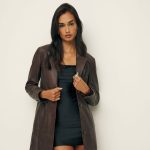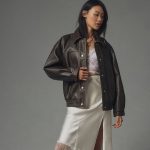The suit, a symbol of sophistication and elegance, holds a prominent place in a gentleman’s wardrobe. But when temperatures drop or the occasion demands an extra layer of warmth, the question arises: is it okay to wear a jacket over a suit? The answer is a resounding yes! In fact, layering a jacket over a suit can not only provide practical protection from the elements but also elevate your style and add a touch of sartorial flair. Let’s explore the nuances of this fashion choice, offering insights into suitable jacket styles, fit considerations, and tips for creating a polished and sophisticated ensemble. Is it okay to wear a jacket over a suit?
The Art of Layering: A Symphony of Style and Function
Is it okay to wear a jacket over a suit? Layering a jacket over a suit is an art form that requires a keen eye for detail and an understanding of proportion and balance.
Warmth and Protection
The primary function of layering a jacket over a suit is to provide additional warmth and protection from the elements, especially during colder months.
Style Elevation
Beyond functionality, a well-chosen jacket can elevate the overall aesthetic of your suit, adding a touch of personality and flair.
Versatility
The ability to layer different jackets over a suit offers versatility and adaptability to various occasions and weather conditions.
Choosing the Right Jacket: A Matter of Style and Occasion
Not all jackets are created equal when it comes to layering over a suit. Certain styles and fabrics are more suitable than others.
-
Overcoats: The overcoat, a timeless classic, is the quintessential choice for layering over a suit. Its long length and structured silhouette provide ample coverage and warmth while exuding an air of sophistication.
-
Topcoats: Topcoats, slightly shorter and lighter than overcoats, offer a more streamlined and contemporary option. They’re perfect for milder weather or when you want a less formal look.
-
Peacoats: Peacoats, with their nautical heritage and double-breasted design, add a touch of rugged elegance to your suit. They’re ideal for casual or business-casual settings.
-
Trench Coats: Trench coats, originally designed for military use, offer a classic and versatile option that’s both stylish and functional. They’re perfect for rainy or windy days.
Fabric and Color Choices:
- Wool and Cashmere: These luxurious fabrics offer exceptional warmth and a refined drape, elevating the overall look of your ensemble.
- Tweed and Herringbone: These textured fabrics add a touch of heritage and personality to your outfit.
- Neutral Colors: Classic colors like black, navy, gray, or camel offer versatility and complement most suit colors.
- Patterned Jackets: For a bolder statement, consider a patterned jacket in a subtle plaid or check. Ensure the pattern complements the color and pattern of your suit.

The Fit Factor: Achieving a Harmonious Silhouette
The fit of your jacket is crucial for creating a polished and flattering layered look.
-
Shoulder Alignment: The jacket’s shoulder seams should align with your natural shoulders, creating a clean and structured line. Avoid jackets that are too tight or too loose in the shoulders.
-
Sleeve Length: The jacket sleeves should be slightly longer than your suit jacket sleeves, allowing about half an inch of the suit jacket cuff to show.
-
Body Length: The jacket should be long enough to cover your suit jacket completely. Ideally, it should extend past your suit jacket’s hem by about an inch or two.
-
Comfort: Ensure the jacket allows for comfortable movement and doesn’t feel restrictive when layered over your suit.
If your jacket doesn’t fit perfectly off the rack, consider having it tailored for a more customized and flattering fit.
While various jacket styles can complement a suit, selecting the perfect one involves considering several factors to ensure a harmonious blend of style, functionality, and appropriateness.
Formal vs. Casual: Matching the Occasion
-
Formal Events: For black-tie events or formal business meetings, a classic overcoat in a dark color like black, navy, or charcoal gray is the most appropriate choice. Its long length and elegant drape perfectly complement the formality of a suit.
-
Business Casual Settings: In a business casual environment, you have more flexibility. A topcoat, peacoat, or even a stylish bomber jacket can add a touch of personality while maintaining a professional appearance.
-
Casual Outings: For casual outings or social gatherings, you can experiment with various jacket styles, including denim jackets, leather jackets, or even quilted jackets, depending on the weather and your personal style.
Fit and Proportion: Achieving a Streamlined Look
-
Shoulder Fit: The jacket’s shoulder seams should align with your natural shoulders, creating a clean and structured line. Avoid jackets that are too tight or too loose in the shoulders.
-
Sleeve Length: The jacket sleeves should be slightly longer than your suit jacket sleeves, allowing about half an inch of the suit jacket cuff to show.
-
Body Length: The jacket should be long enough to cover your suit jacket completely. Ideally, it should extend past your suit jacket’s hem by about an inch or two.
-
Avoid Bulk: Opt for a jacket that fits comfortably over your suit without adding excessive bulk. Avoid overly padded or oversized jackets that can make you appear larger than you are.

Material Matters: Comfort and Style
The choice of fabric for your jacket can significantly impact its warmth, breathability, and overall aesthetic.
-
Wool and Cashmere: These luxurious fabrics offer exceptional warmth and a refined drape, elevating the overall look of your ensemble. They’re perfect for colder months or formal occasions.
-
Tweed and Herringbone: These textured fabrics add a touch of heritage and personality to your outfit. They’re suitable for both casual and business-casual settings.
-
Cotton and Linen: Lightweight cotton or linen jackets are ideal for warmer weather or layering in air-conditioned environments. They offer breathability and a more relaxed feel.
-
Leather and Suede: Leather and suede jackets add an edgy and stylish touch to your suit. Choose a fitted style for a sleek look or an oversized bomber for a more casual vibe.
Color Coordination: Creating a Harmonious Ensemble
The color of your jacket should complement the color of your suit, creating a visually pleasing and cohesive look.
-
Neutral Colors: Classic colors like black, navy, gray, or camel offer versatility and pair well with most suit colors.
-
Complementary Colors: If you’re feeling adventurous, experiment with complementary colors. For example, a navy suit can be paired with a brown or burgundy jacket.
-
Patterned Jackets: If you opt for a patterned jacket, ensure the pattern’s scale and colors complement the suit. A subtle plaid or check can add a touch of personality without overwhelming the look.
Accessorizing: The Finishing Touches
Accessories can further enhance your layered look and add a touch of personal flair.
-
Scarves: A scarf can add warmth, color, and texture to your ensemble. Choose a scarf that complements the color palette of your suit and jacket.
-
Hats: A fedora or a beanie can add a touch of personality and complete your look, especially during colder months.
-
Gloves: Leather gloves or knit gloves can add both warmth and style to your outfit.
-
Bags: Choose a bag that complements the formality of your attire. A briefcase or a leather messenger bag is ideal for professional settings, while a tote or a backpack can be suitable for more casual occasions.

Conclusion
Is it okay to wear a jacket over a suit? Layering a jacket over a suit is not only acceptable but also a stylish and practical way to enhance your wardrobe and adapt to various occasions and weather conditions. By choosing the right jacket style, ensuring a proper fit, and coordinating colors and textures thoughtfully, you can create a polished and sophisticated ensemble that exudes confidence and sartorial flair.
Remember, the key is to strike the right balance between formality and individuality, allowing your personal style to shine through while maintaining a professional appearance.



